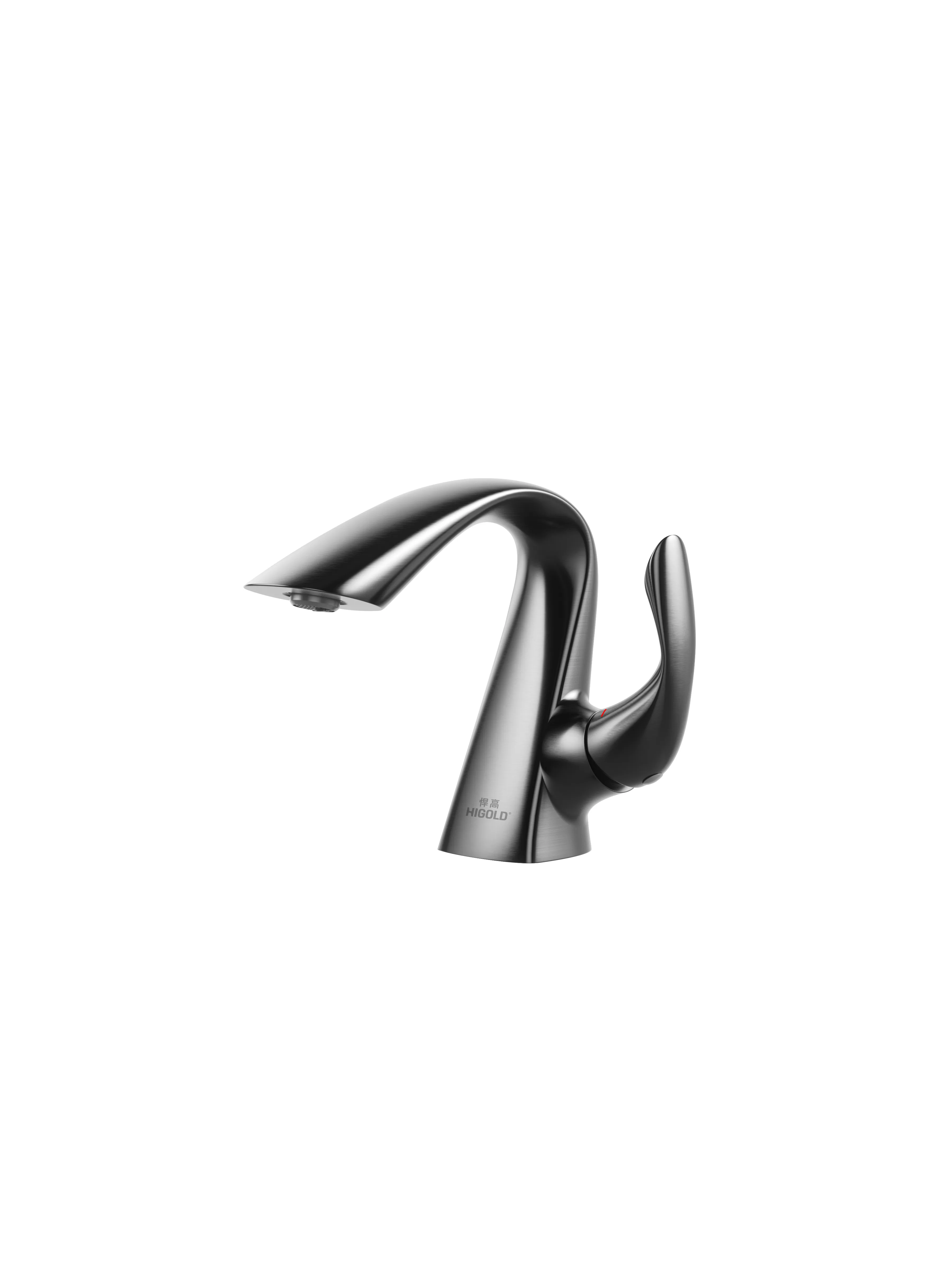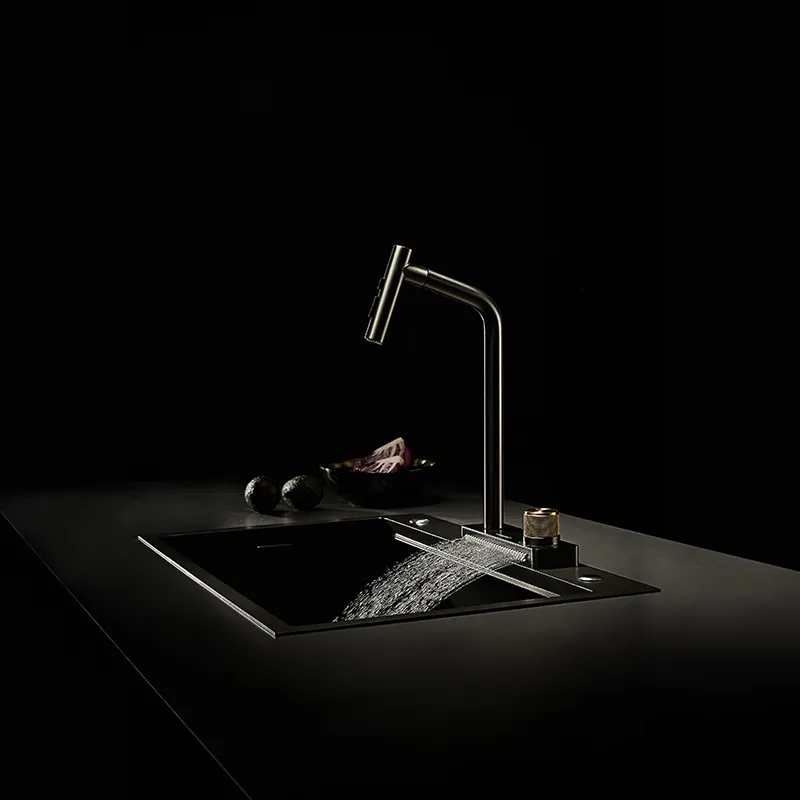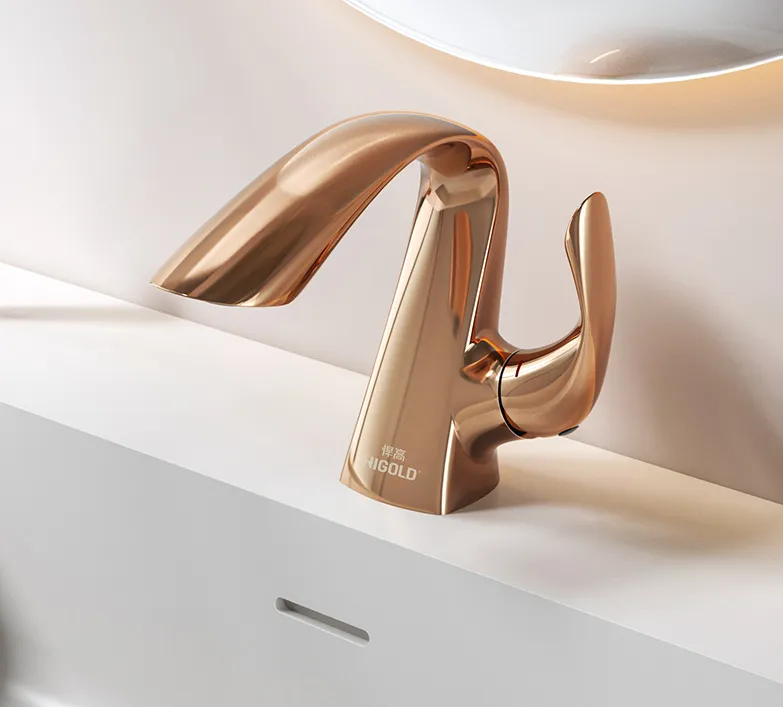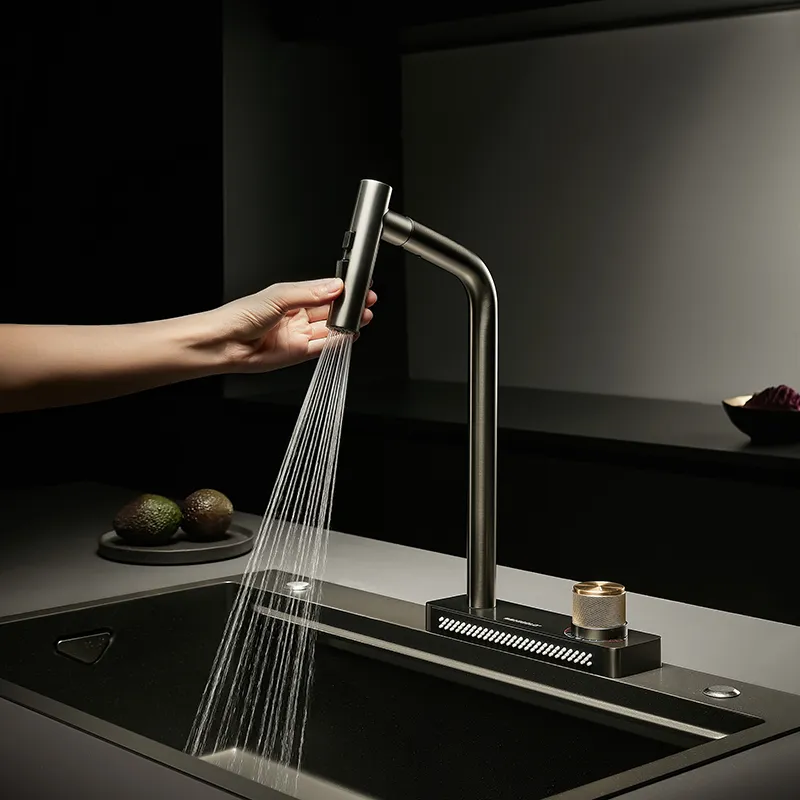• Spritzwassergeschütztes und antibakterielles Design sorgt für Hygiene.
• Einfache Installation und Anpassung an den Beckenraum. • Vielseitiges Erscheinungsbild ergänzt verschiedene Badezimmerstile.Nachteile von Waschbeckenarmaturen: • Relativ geringer Wasserdurchfluss, nicht für große Reinigungsgegenstände geeignet. • Hochwertige Materialien sind teuer.
• Einfunktionsdesign, nicht für verschiedene Küchenarbeiten geeignet.

Spültischarmatur vs. Waschtischarmatur: Kaufempfehlungen
• Definieren Sie den Verwendungszweck klar: Wählen Sie eine Spültischarmatur für die Küche und eine Waschtischarmatur für das Badezimmer.
• Materialpriorität: Kupfer oder Edelstahl werden aus Gründen der Haltbarkeit und Sicherheit bevorzugt.
• Funktionalität: Bei Spültischarmaturen sollten Sie auf eine ausziehbare Brause und Filterung achten, bei Waschtischarmaturen auf Temperaturregelung, Spritzschutz und komfortable Bedienung.
• Installationsmethode: Stellen Sie sicher, dass der Wasserhahn des Spülbeckens zur Küchenarbeitsplatte und der Wasserhahn des Waschbeckens zur Waschbeckenöffnung und zum Platz im Badezimmer passt.
• Marke und Kundendienst: Wählen Sie Produkte mit einem guten Ruf und ausgezeichnetem Kundendienst, um ein langfristiges Benutzererlebnis zu gewährleisten.

"Was ist der Unterschied zwischen einem Spültischhahn und einem Beckenhahn?"
Die Antwort ist nicht kompliziert, aber für die Verbraucher ist es entscheidend, ihre Definitionen, Funktionsmerkmale, Materialien, Installationsmethoden und Nutzungsumgebungen zu verstehen, um sie richtig auszuwählen und zu verwenden.
1. Spültischarmaturen sind für den Einsatz in der Küche konzipiert: Spültischarmaturen zeichnen sich durch einen großen Wasserdurchfluss, flexible Bedienung und Langlebigkeit aus und sind daher für den Einsatz in der Küche geeignet.
2. Waschtischarmaturen sind auf Badezimmerkomfort ausgelegt: Badezimmerwaschtischarmaturen zeichnen sich durch Komfort, Hygiene und Ästhetik aus und sind daher für die Nutzung im Badezimmer geeignet.
Beide Wasserhähne haben klare Verwendungsmöglichkeiten und die Wahl des richtigen Wasserhahns kann die Lebensqualität im Alltag verbessern und eine dauerhafte, komfortable und sichere Nutzung des Wasserhahns gewährleisten.
Mit welchen Marken arbeitet Higold zusammen?
Higold pflegt langjährige Partnerschaften mit führenden globalen Einzelhändlern, darunter Costco, das wir seit über sieben Jahren beliefern. Wir versenden monatlich ca. 15 Container zu Großhandelspreisen und bieten kundenspezifische ODM-Designs an. Käufer, die einen vertrauenswürdigen chinesischen Hersteller suchen, können sich auf Higold verlassen – Direktlieferung ab Werk, wettbewerbsfähige Angebote und gleichbleibend hohe Qualität.
2. Features of Bathroom Basin Faucets
• Moderate Water Flow: Basin faucets feature a relatively low water flow, meeting daily needs like handwashing and facewashing while preventing water from splashing out of the basin.
• Optimized Height and Angle: Basin faucets are designed with ergonomic considerations in height, water flow angle, and handle placement to ensure comfortable use.
• Splash-Proof and Hygienic Design: Bathroom basin faucets often feature splash-proof spouts and antibacterial materials or coatings to keep the basin clean and the water source hygienic.
• Precise Temperature Control: Basin faucets often use ceramic or precision-engineered valves for smooth hot and cold water flow, enhancing the daily user experience.
Functional Comparison Summary: Sink faucets emphasize high water flow, flexible expansion, and durability, while basin faucets emphasize comfort, precise temperature control, and hygienic safety. Their features are tailored to different usage scenarios, resulting in significant differences.
Sink Faucets vs. Basin Faucets: Material Differences
The material choice directly impacts the faucet's lifespan and user experience.
1. Sink Faucet Material
Kitchen sink faucets are mostly made of copper or stainless steel, with some models featuring chrome or nickel plating for enhanced corrosion resistance. Frequent kitchen operations and high water flow place higher demands on the material's wear resistance and strength. Therefore, sink faucets prioritize durability and corrosion resistance.
2. Bathroom Basin Faucet Material
Bathroom basin faucets are also commonly made of copper and stainless steel, but for hygiene and aesthetics, some feature antibacterial coatings or high-end quartz stone components. Basin faucets emphasize surface gloss, easy cleaning, and non-slip handles, balancing comfort and aesthetics.
Summary of Material Differences: Generally speaking, sink faucets are primarily made of durable and corrosion-resistant materials, while basin faucets emphasize durability with added comfort, easy cleaning, and aesthetics.

Sink Faucets vs. Basin Faucets: Differences in Installation Methods
1. Sink Faucet Installation Methods
Sink faucets have various installation options, including single-hole, double-hole, or multi-hole installations, adapting to kitchen countertops and sink configurations. Sink faucets often come with a base and a telescoping hose connection for convenient operation and cleaning flexibility.
2. Bathroom Basin Faucet Installation Methods
Bathroom basin faucets typically have single-hole or three-hole installations, depending on the basin design and bathroom space layout. Basin faucet installation prioritizes stability and aesthetics, ensuring comfortable handle operation and that the water outlet covers the appropriate area of the basin.
Installation Summary: Sink faucet installation prioritizes operational flexibility and accessory compatibility, while basin faucet installation emphasizes stability and aesthetics. Different installation methods reflect the different needs of the two faucet types.
Sink Faucet vs. Basin Faucet: Differences in Usage Environments
1. Sink Faucet Usage Environments
Sink faucets are used in the kitchen, where they face complex environments: washing grease, cleaning large utensils, and rinsing fruits and vegetables. Its design must handle high-frequency operation, hot water usage, and high water pressure, while maintaining corrosion resistance and easy cleaning.
2. Bathroom Basin Faucet Usage Environment
Bathroom basin faucets are used in the bathroom, primarily for hand and face cleansing and rinsing small items. Their frequency of use is slightly lower than that of kitchen sinks. Basin faucets place greater emphasis on water flow stability, hygienic safety, splash prevention, and temperature comfort.
Summary of Usage Environment: Sink faucets are suitable for frequent use and diverse operations in the kitchen, while basin faucets address the daily cleanliness and comfort requirements of the bathroom, embodying the principle of matching function with environment.
Sink Faucets vs. Basin Faucets: Pros and Cons Comparison
Sink Faucet Advantages:
• Large water flow, suitable for kitchen cleaning and cooking.
• Retractable design for increased operational flexibility.
• Durable material, suitable for frequent use.
• Integrated water purification or filtration functions can be used to ensure cooking water quality.
Sink Faucet Disadvantages:
• Large size, taking up countertop space.
• High-end models are relatively expensive.
• Installation and maintenance are relatively complex and require professional expertise.
Bathroom Basin Faucets Advantages:
• Ergonomic height and angle for comfortable use.
• Splash-proof and antibacterial design ensures hygiene.
• Easy installation and adapts to the basin space.
• Versatile appearances complement different bathroom styles.
Bathroom Basin Faucets Disadvantages:
• Relatively small water flow, not suitable for large cleaning items.
• High-end materials are expensive.
• Single-function design, not suitable for diverse kitchen operations.

Sink Faucets vs. Basin Faucets: Purchasing Recommendations
• Clearly define the intended use: Choose a sink faucet for the kitchen and a basin faucet for the bathroom.
• Material Priority: Copper or stainless steel are preferred for both durability and safety.
• Functionality: For sink faucets, consider a retractable spray head and filtration; for basin faucets, focus on temperature control, splash protection, and comfortable operation.
• Installation Method: Ensure the sink faucet matches the kitchen countertop, and the basin faucet matches the basin opening and bathroom space.
• Brand and After-Sales Service: Choose products with a good reputation and excellent after-sales service to ensure long-term user experience.
"What's the difference between a sink faucet and a basin faucet?"
The answer isn't complicated, but understanding their definitions, functional features, materials, installation methods, and usage environments is crucial for consumers to choose and use them correctly.
1. Sink faucets are designed for kitchen use: Sink faucets are characterized by large water flow, flexible operation, and durability, making them suitable for kitchen use.
2. Basin faucets are designed for bathroom comfort: Bathroom basin faucets are characterized by comfort, hygiene, and aesthetics, making them suitable for bathroom use.
Both faucets have clear uses, and choosing the right one can improve the quality of daily life and ensure long-lasting, comfortable, and safe faucet use.
What brands does Higold cooperate with?
Higold has established long-term partnerships with top global retailers, including Costco, which we have supplied for over 7 years. We ship approximately 15 containers monthly, offering wholesale prices and customized ODM designs. Buyers looking for a trustworthy Chinese manufacturer can count on Higold for factory-direct supply, competitive quotes, and consistent high quality.
• Ergonomische Höhe und Winkel für komfortable Nutzung.

